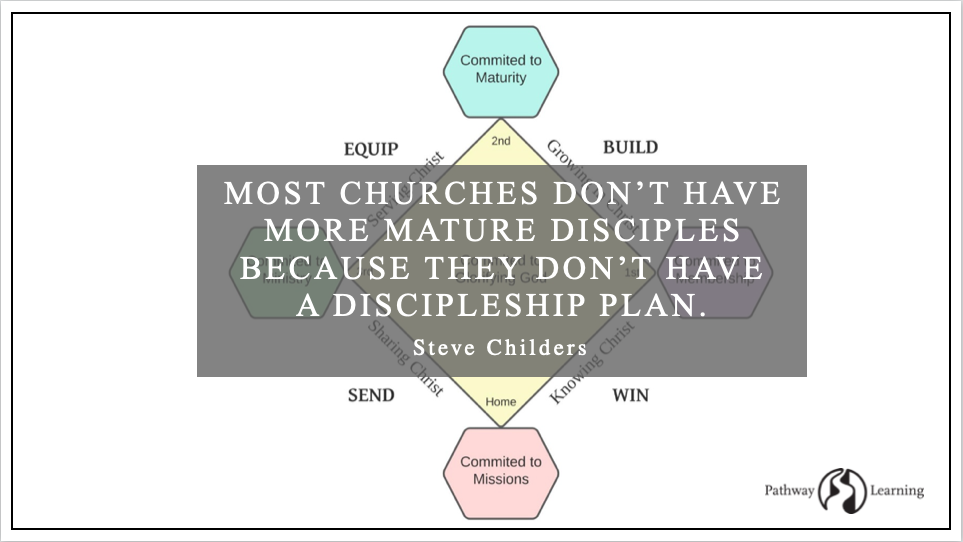How to Develop an Effective Discipleship Plan: How to Make Disciples Series Part 6
By Steven L. Childers
Want to go deeper?
In this book you'll be equipped from Scripture with the principles and practices needed to help you design and develop effective discipleship ministries in your church through which people are led to faith in Christ and a lifestyle of ongoing spiritual growth and Christian service. Discover practical insights from Jesus’ discipleship methods. You’ll learn how to:
Discover practical insights from Jesus' discipleship methods (Chapter 1)
Explain the nature and benefits of an intentional discipleship plan (Chapter 2)
Describe the benefits of balanced (and dangers of imbalanced) purposes in discipleship (Chapter 3)
Summarize the nature and value of five types of church discipleship strategies (Chapter 4)
Design a discipleship model for developing fully-devoted followers of Christ (Chapter 5)
Introduce a process for implementing discipleship pathways in your church (Chapter 6)
Preview the Book
Transcript
Introduction
The reason most local churches do not have more mature disciples is that they don’t have an intentional discipleship plan. When many discipleship plans are carefully evaluated, they’re often outdated and ineffective.
So in this final session, our focus is on practical ways to develop and execute an intentional, effective discipleship plan in a local church.
However, as has been made clear earlier, we need to remember that discipleship takes place in the context of relationships and ministry. So a discipleship plan should be designed for implementation through relationships in groups that are intentionally focused on spiritual nurture and ministry.
Beginning with The End in Mind
Also, an effective discipleship plan should consist of intentional pathways, with practical steps that can help someone, at any level of spiritual maturity, become a more fully devoted follower of Jesus.
Like any plan, for a discipleship plan to be effective it must be designed with a clearly defined, measurable outcome in mind. The Bible tells us the final outcome of biblical discipleship is someone who is conformed to the image of Christ and marked by genuine love for God and others.
And the gospel is restoring not only their relationship to God, but also their relationships with others and the world as they devote themselves to things like worship, prayer, learning, fellowship, evangelism, mercy, and missions.
Developing A Strategic Plan
So how do you help people make progress on a discipleship pathway from where they are now to greater levels of spiritual maturity? We learned earlier that there is no magic template. One discipleship plan or method will not work in all situations.
But there are principles and practices we can draw on to help us develop discipleship plans that are effective in our unique situation. For instance, effective planning involves asking and answering three basic questions: 1) Where are you now?, 2)Where do you want to go?, and 3) What is your plan to get there?
Where are you now?
Let’s begin with the question: Where are you now? The spiritual maturity of the people you serve in ministry will always vary broadly. Some may have a high degree of spiritual maturity, while others may still be seekers.
This is why your discipleship strategy should have several “entry points” for people at different levels of spiritual maturity. For the less mature, the commitment level should often be similar to Jesus’ call for his followers to “come and see.” But for the more mature, the appropriate call to commitment might be more like Jesus’ call to his mature followers to “come and die.”
Less mature believers need entry points to basic discipleship, while more mature believers need entry points to more advanced discipleship.
For example, less mature believers may need a discipleship plan that includes encouraging them to attend public worship regularly. But more mature believers may need a discipleship plan that includes teaching them more in-depth biblical principles and practices of worship.
Where do you want to go?
This brings us to the second question: Where do you want to go? It’s not enough to know that the ultimate goal of discipleship is someone who is conformed to the image of Jesus Christ and marked by genuine love for God and others.
We also need to understand biblical and practical milestones people need to reach on their pathways to become more mature disciples. These milestones are vital signs of a spiritually healthy disciple. So an effective discipleship plan should include the development of several, practical sub-plans related to each of these biblical milestones, including a:
Worship Discipleship Plan
Prayer Discipleship Plan
Learning Discipleship Plan
Fellowship Discipleship Plan
Evangelism Discipleship Plan
Mercy/Justice Discipleship Plan
Missions Discipleship Plan
The desired outcomes of each of these discipleship plans should be holistic, including a balanced focus on renewing peoples’ understanding, heart affection, and behavior.
For example, a church’s discipleship plan for worship should include helping people develop a more biblical understanding of worship. But it should also include helping people apply that understanding to their heart affections and behaviors in worship.
What is your plan to get there?
The final question is, “What is your plan to get there?”
In other words, what strategy will you employ to use these discipleship plans to help people make progress toward greater levels of spiritual maturity?
One approach is to help people complete all these discipleship plans in a linear, sequential order. This approach always begins and ends with the same plan, for example it always begins with the Worship Discipleship Plan and ends with the Missions Discipleship Plan. The downside of this approach is that people are often not motivated to learn concepts in this order, and when people are not motivated, they usually don’t learn.
Another approach is to first help people complete the discipleship plans they are most interested in. This approach is usually more effective because people are motivated to learn topics that relate to their present questions and/or problems. But the downside of this approach is that people often neglect to focus on other discipleship plans they need.
Toward An Effective Master Discipleship Plan
An effective master discipleship plan will integrate both approaches, offering people the options of both a sequential order of discipleship plans and opportunities to take individual plans according to their unique interests and needs.
It can also be helpful to design a master discipleship plan, with courses designed for people to take in small groups.[1] This master plan should reflect how the gospel restores our relationship to God, others, and the world.
Restoring Our Relationship With God
Worship
Prayer
Restoring Our Relationship With Others
Learning
Fellowship
Restoring Our Relationship With World
Evangelism
Mercy
Missions
Conclusion
Lives are transformed through intentional, way-of-life discipleship following the Master’s method. When we design intentional pathways for discipleship based on biblical truths and principles, we serve, love, and honor God and those being discipled.
Footnotes:
[1] Pathway Learning provides online and onsite courses for all these plans in several languages: https://courses.pathwaylearning.org/library/


